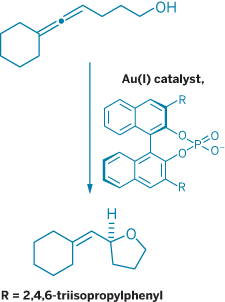Advertisement
Grab your lab coat. Let's get started
Welcome!
Welcome!
Create an account below to get 6 C&EN articles per month, receive newsletters and more - all free.
It seems this is your first time logging in online. Please enter the following information to continue.
As an ACS member you automatically get access to this site. All we need is few more details to create your reading experience.
Not you? Sign in with a different account.
Not you? Sign in with a different account.
ERROR 1
ERROR 1
ERROR 2
ERROR 2
ERROR 2
ERROR 2
ERROR 2
Password and Confirm password must match.
If you have an ACS member number, please enter it here so we can link this account to your membership. (optional)
ERROR 2
ACS values your privacy. By submitting your information, you are gaining access to C&EN and subscribing to our weekly newsletter. We use the information you provide to make your reading experience better, and we will never sell your data to third party members.
Synthesis
Chirality From Counterions
Chiral anions lead to high enantioselectivities
by Bethany Halford
July 30, 2007
| A version of this story appeared in
Volume 85, Issue 31

OFTEN CONSIDERED little more than spectators in chemical transformations, anionic counterions can confer considerable enantioselectivity in metal-catalyzed reactions, according to a new study. By employing chiral binaphthol-derived phosphate anions in gold(I)-catalyzed reactions, chemists at the University of California, Berkeley, have found that they can generate products in 90 to 99% enantiomeric excess (ee) (Science 2007, 317, 496).
Using chiral anions to influence chirality in metal-catalyzed reactions has been reported before, but this is the first time anyone has achieved such high enantioselectivities with this strategy, says F. Dean Toste, who spearheaded the research along with colleagues Greg Hamilton, Eun Joo Kang, and Miriam Mba. "We're always looking for different tools to control selectivity in our reactions, and this is another one we can add to our repertoire," Toste says.
In transition-metal catalysis, stereochemistry is usually governed by chiral ligands, which tightly bind the catalytic metal and thereby induce asymmetric products. Toste's group reasoned that a chiral counterion, held tightly to the metal as an ion pair, might also strongly influence the stereochemical outcome of a reaction.
"This idea is potentially very powerful," Toste notes, because "a small library of chiral anionic counterions could be used to make a wide range of cationic catalysts enantioselective."
In the gold(I)-catalyzed intramolecular hydroalkoxylation of allenols, Toste's team found that, by using a chiral binaphthol-derived phosphate counterion, they could generate chiral monosubstituted tetrahydrofuran products in good yields with greater than 90% enantiomeric excess. The same reaction carried out with a chiral phosphine ligand, rather than a chiral counterion, gave poor enantioselectivities. The chiral counterion strategy also worked well for gold-catalyzed enantioselective intramolecular hydroaminations.
However, when the researchers attempted to use the chiral counterion approach in gold-catalyzed intramolecular hydrocarboxylations, they were initially disappointed. Chiral ligands also failed to produce good enantioselectivities for this transformation. But when Toste's group combined a chiral counterion and a chiral ligand in the reaction mixture, the combination proved to be synergistic, giving the substituted lactone product in 88% yield and 82% ee. The team is currently trying to use this synergistic approach with other metal-mediated reactions.
"The dramatic effect of a chiral counterion on the stereochemical course of gold(I)-catalyzed cyclofunctionalization reactions represents a significant advance in the practice of asymmetric catalysis," says Scott E. Denmark, a chemistry professor at the University of Illinois, Urbana-Champaign. "The potential for counterion effects in myriad cationic transition-metal transformations is almost limitless."



Join the conversation
Contact the reporter
Submit a Letter to the Editor for publication
Engage with us on Twitter